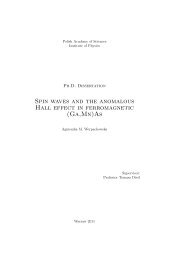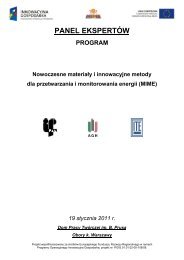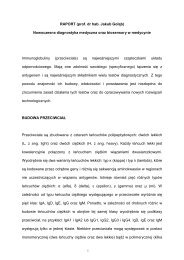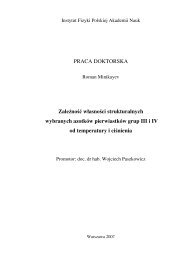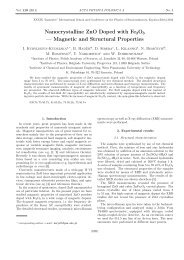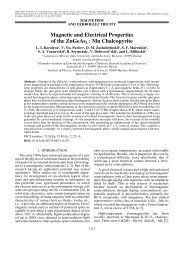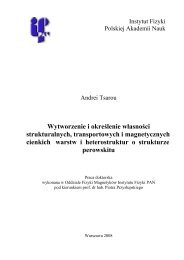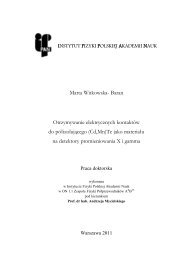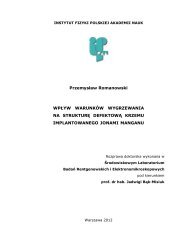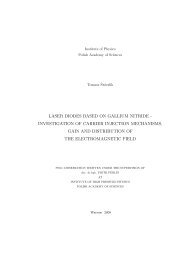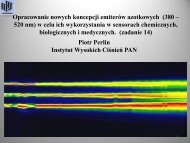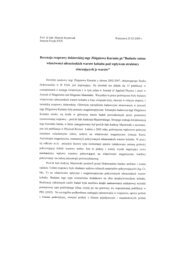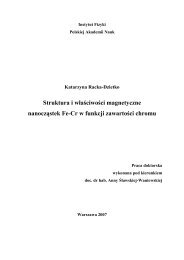Geometrical and Electrical Properties of Indium Tin Oxide Clusters in ...
Geometrical and Electrical Properties of Indium Tin Oxide Clusters in ...
Geometrical and Electrical Properties of Indium Tin Oxide Clusters in ...
- No tags were found...
Create successful ePaper yourself
Turn your PDF publications into a flip-book with our unique Google optimized e-Paper software.
Articlepubs.acs.org/Langmuir<strong>Geometrical</strong> <strong>and</strong> <strong>Electrical</strong> <strong>Properties</strong> <strong>of</strong> <strong>Indium</strong> <strong>T<strong>in</strong></strong> <strong>Oxide</strong> <strong>Clusters</strong> <strong>in</strong>Ink DispersionsMateusz Sikora, †, * Dieter Adam, ‡ Piotr M. Korczyk, §,⊥ Anna Prodi-Schwab, ‡ Piotr Szymczak, ∥<strong>and</strong> Marek Cieplak †† Institute <strong>of</strong> Physics, Polish Academy <strong>of</strong> Sciences, Aleja Lotnikoẃ 32/46, 02-668 Warsaw, Pol<strong>and</strong>‡ Evonik Industries AG, Paul-Baumann-Strasse 1, 45772 Marl, Germany§ Institute <strong>of</strong> Fundamental Technological Research, Polish Academy <strong>of</strong> Sciences, ul. Paw<strong>in</strong>śkiego 5B, 02-106 Warsaw, Pol<strong>and</strong>⊥ Institute <strong>of</strong> Physical Chemistry, Polish Academy <strong>of</strong> Sciences, ul. Kasprzaka 44/52, 01-224 Warsaw, Pol<strong>and</strong>∥ Institute <strong>of</strong> Theoretical Physics, Faculty <strong>of</strong> Physics, University <strong>of</strong> Warsaw, ul. Hozȧ 69, 00-681 Warsaw, Pol<strong>and</strong>ABSTRACT: The analysis <strong>of</strong> the TEM images <strong>of</strong> <strong>in</strong>dium t<strong>in</strong>oxide (ITO) clusters <strong>in</strong> <strong>in</strong>k solutions deposited from <strong>in</strong>kdispersions reveals that their geometry arises from a diffusionlimited cluster aggregation (DLCA) process. We model films<strong>of</strong> ITO clusters as built through deposition <strong>of</strong> DLCA clustersmade <strong>of</strong> primary spherical nanoparticles <strong>of</strong> 13 nm <strong>in</strong> diameter.The deposition is then followed by a further compactificationprocess that imitates s<strong>in</strong>ter<strong>in</strong>g. We determ<strong>in</strong>e the conductivity<strong>of</strong> the s<strong>in</strong>tered films by mapp<strong>in</strong>g the problem to that <strong>of</strong> theresistor network <strong>in</strong> which the contact regions between thetouch<strong>in</strong>g spheres provide the dom<strong>in</strong>ant electric resistance. For a given volume fraction, conductivity <strong>of</strong> the s<strong>in</strong>tered films isshown to be larger than that for the r<strong>and</strong>omly packed spheres. However, the larger a typical radius <strong>of</strong> gyration <strong>of</strong> the clusters thesmaller the enhancement. We also provide numerical tests for the rout<strong>in</strong>es used <strong>in</strong> the <strong>in</strong>terpretation <strong>of</strong> the TEM images.■ INTRODUCTIONTransparent conductive oxides serve as electrodes <strong>in</strong> flat-paneldisplay devices (to control orientation <strong>of</strong> liquid crystals) 1 <strong>and</strong> <strong>in</strong>photovoltaics (to tap photogenerated carriers). 2 Their remarkableproperties stem from the wide gap character <strong>of</strong> theelectronic b<strong>and</strong> structure comb<strong>in</strong>ed with the dop<strong>in</strong>g-<strong>in</strong>ducedmetallic-like electric conduction. Such systems are typicallyemployed <strong>in</strong> the form <strong>of</strong> th<strong>in</strong> films <strong>and</strong> their examples <strong>in</strong>cludeZnO doped with Al or Ga, 3,4 SnO 2 doped with F or Sb, 4 <strong>and</strong>CdO doped with Y, Sc, or In. 5 However, In 2 O 3 doped with Sn(ITO, <strong>in</strong>dium t<strong>in</strong> oxide) with a dop<strong>in</strong>g level <strong>of</strong> order 5−10 at.% appears to have superior optical transmittivity <strong>in</strong> the visiblerange <strong>and</strong> the smallest resistivity <strong>in</strong> the set. 6,7 In addition, ITOreflects the <strong>in</strong>frared light so it can also function as a heat filter. 8ITO is an n-type semiconductor with the bixbyite crystalstructure <strong>and</strong> the carrier density <strong>of</strong> order 10 21 1/cm 3 comesfrom two different k<strong>in</strong>ds <strong>of</strong> donors (O vacancies <strong>and</strong> Snsubstitut<strong>in</strong>g In). 9There are many well established methods <strong>of</strong> layer depositionthat enable production <strong>of</strong> th<strong>in</strong> ITO films (see references <strong>in</strong>, e.g.,ref 10). They <strong>in</strong>volve vacuum techniques, advanced apparatus,<strong>and</strong> elevated temperatures. The latter feature is an obstaclewhen deal<strong>in</strong>g with flexible polymeric substrates which is one <strong>of</strong>many motivations, <strong>in</strong>clud<strong>in</strong>g achiev<strong>in</strong>g reduction <strong>in</strong> themanufactur<strong>in</strong>g costs, to explore novel ways <strong>of</strong> production <strong>of</strong>the ITO films. A promis<strong>in</strong>g new method <strong>in</strong>volves mak<strong>in</strong>gdispersion, or ”<strong>in</strong>ks”, <strong>of</strong> ITO nanoparticles which are suitablefor wet deposition techniques, such as sp<strong>in</strong>- <strong>and</strong> dip-coat<strong>in</strong>g<strong>and</strong> pr<strong>in</strong>t<strong>in</strong>g. 11,10 Scratch resistant acrylic coat<strong>in</strong>gs have alsobeen developed commercially by Evonik-Industries. 12 Thenanoparticles themselves are made by the sol−gel technique. 13There have also been reports on us<strong>in</strong>g the <strong>in</strong>kjet pr<strong>in</strong>ted films<strong>in</strong> solar cells. 14,15Here, we analyze <strong>and</strong> then model the properties <strong>of</strong>nanoparticles <strong>in</strong> <strong>in</strong>k formulations designed by EvonikIndustries 15,16 for usage <strong>in</strong> pr<strong>in</strong>table electronics. Theseformulations are water or ethanol based <strong>and</strong> they conta<strong>in</strong> adispersant. They are stable <strong>and</strong> conta<strong>in</strong> particles <strong>of</strong> about 100nm <strong>in</strong> size. Each <strong>of</strong> the particles is an agglomerate <strong>of</strong> primarynanoparticles which are about 13 nm <strong>in</strong> diameter. The primarynanoparticles are crystall<strong>in</strong>e <strong>in</strong> structure. We show that theagglomerates are fractals 17 with the fractal dimensionality, d f ,<strong>of</strong>about 1.80. We <strong>in</strong>terpret this value as be<strong>in</strong>g consistent with theprocess <strong>of</strong> diffusion limited cluster aggregation (DLCA) 18−20 <strong>in</strong>which both the grow<strong>in</strong>g clusters <strong>and</strong> the primary particles move<strong>in</strong> space <strong>and</strong> aggregate. We then model the formation the ITOclusters as DLCA-like aggregation <strong>of</strong> clusters composed <strong>of</strong> hardspheres <strong>and</strong> analyze the statistical properties <strong>of</strong> the aggregates.The diameter <strong>of</strong> a sphere is taken as equal to 13 nm to imitateproperties <strong>of</strong> the Evonik <strong>in</strong>k formulation.Received: October 3, 2011Revised: November 28, 2011Published: December 2, 2011© 2011 American Chemical Society 1523 dx.doi.org/10.1021/la203886b | Langmuir 2012, 28, 1523−1530
LangmuirArticleFigure 1. Left panel: a TEM image <strong>of</strong> the ITO clusters deposited from <strong>in</strong>k dispersion PH37384 <strong>in</strong> test US12 (frame 56342). Right panel: The highlymagnified TEM image <strong>of</strong> a primary ITO particle.In the next technological step for the systems consideredhere, the formulation is <strong>in</strong>kjetted onto a glass (or plastic)substrate <strong>and</strong> dried. Further postprocess<strong>in</strong>g <strong>in</strong>volves s<strong>in</strong>ter<strong>in</strong>g at550 °C <strong>and</strong> then at 300 °C <strong>in</strong> reduc<strong>in</strong>g atmosphere (5%H 2 <strong>and</strong>95% N 2 ). This results <strong>in</strong> a layer <strong>of</strong> 0.5−2.0 μm, roughness <strong>of</strong> 10nm rms, porosity <strong>of</strong> 35−45% <strong>and</strong> sheet resistance <strong>of</strong> about 100Ω/sq. The optical tranmittance is 90%. The mobility <strong>and</strong>carrier density <strong>in</strong> nanoporous ITO films have been measured<strong>and</strong> discussed <strong>in</strong> ref 21. In this paper, we model the s<strong>in</strong>teredfilms by implement<strong>in</strong>g compactification <strong>of</strong> the hard sphereclusters <strong>and</strong> then study the result<strong>in</strong>g resistivities as a function <strong>of</strong>the characteristic cluster size <strong>and</strong> porosity.■ ANALYSIS OF CLUSTER IMAGESFigure 1 shows an example <strong>of</strong> a transmission electronmicroscopy (TEM) image result<strong>in</strong>g from ITO <strong>in</strong>k depositionon a glass substrate. The right panel shows an image <strong>of</strong> aprimary ITO particle. The particle has crystall<strong>in</strong>e features yet itis fairly compact. Thus, at the length scales <strong>of</strong> the ITO clustersthe particle can approximately represented by a sphere. Ourtask at h<strong>and</strong> is to <strong>in</strong>terpret such images through imageprocess<strong>in</strong>g <strong>in</strong> terms <strong>of</strong> s<strong>in</strong>gle cluster geometrical characteristics.There is a substantial collective experience <strong>in</strong> analyz<strong>in</strong>g TEMimages <strong>of</strong> agglomerated particles that has been accumulated <strong>in</strong>the literature. 22,24,25,29,30 We follow the developed techniques,comb<strong>in</strong>ed with us<strong>in</strong>g the Matlab Image Process<strong>in</strong>g Toolbox toretrieve data on image brightness from the TEM images. Theimage is divided <strong>in</strong>to pixels. The l<strong>in</strong>ear pixel size is either 9.5, or4.7, or 1.9 nm, depend<strong>in</strong>g on the magnification level <strong>of</strong> aspecific image.We have used a simple threshold based approach todist<strong>in</strong>guish clusters from the background on the images. Thethreshold value is chosen to be equal to the median brightnesslevel across whole image. The pixels with the brightness fall<strong>in</strong>gbellow the median are considered as belong<strong>in</strong>g to the clusters.This procedure generates a logical mask image which is thenpartitioned <strong>in</strong>to clusters <strong>of</strong> connected pixels. Once the clustersare identified, we proceed to analyz<strong>in</strong>g distribution <strong>of</strong>brightness correspond<strong>in</strong>g to <strong>in</strong>dividual clusters <strong>in</strong> the TEMimages.The brightness level, I(x,y), <strong>of</strong> a pixel at location (x,y)depends on the projection <strong>of</strong> a 3-dimensional structure (Figure2) on the plane <strong>of</strong> the substrate as it orig<strong>in</strong>ates from thetransmission <strong>of</strong> the electron beam through the cluster along theFigure 2. Top: the light transmission pattern correspond<strong>in</strong>g to one <strong>of</strong>the clusters present <strong>in</strong> Figure 1. Bottom: its 3-dimensionalreconstruction.z-axis. I(x,y) does not conta<strong>in</strong> a full <strong>in</strong>formation about thestructure <strong>of</strong> a cluster, but this is the only <strong>in</strong>formation availableexperimentally. Accord<strong>in</strong>g to the Lambert−Beer law known <strong>in</strong>optics, we can expect that I(x,y) depends on the total depth <strong>of</strong>the cluster at (x,y) exponentially:⎛I( x, y) = I0exp⎜−⎝lx ( , y)⎞⎟α ⎠Here I 0 denotes the brightness <strong>of</strong> <strong>in</strong>cident beam <strong>and</strong> α is theabsorption length. We assume that both <strong>of</strong> these parameters areconstant. Furthermore, we assume that I 0 is given by thebrightness <strong>of</strong> the background, as estimated by the median value<strong>of</strong> the brightness. Equation 1 implies that the depth <strong>of</strong> a layercan be evaluated from digital image by(1)1524dx.doi.org/10.1021/la203886b | Langmuir 2012, 28, 1523−1530
LangmuirArticleFigure 3. Left panel: volume, V, <strong>of</strong> the clusters versus R g obta<strong>in</strong>ed for the set <strong>of</strong> clusters correspond<strong>in</strong>g to the TEM image shown <strong>in</strong> Figure 1. Rightpanel: Surface area <strong>of</strong> the projections <strong>of</strong> the clusters considered <strong>in</strong> the left panel versus R g . The <strong>in</strong>dicated slope correponds to 1.77.=−α ⎛ ⎝ ⎜ Ix ( , y)⎞lx ( , y) ln ⎟I0 ⎠(2)The α coefficient is evaluated from a series <strong>of</strong> measurements <strong>of</strong>the smallest objectsthe primary nanoparticles. Assum<strong>in</strong>g thatthe crystallites are spherical, their depth is statistically equal totheir width. By measur<strong>in</strong>g the brightness at the center <strong>of</strong> acrystallite <strong>and</strong> its width, we estimate α to be equal to 2.22 ±0.34 nm.The volume <strong>of</strong> a cluster can be evaluated by:2∑V = w l( x, y)xy , (3)where w denotes the height <strong>and</strong> width <strong>of</strong> a square pixel. Thesum extends over all (x,y) pixel positions belong<strong>in</strong>g to thecluster. The volume can also be expressed by a nondimensionalnumber N by divid<strong>in</strong>g it by a volume, w 3 , <strong>of</strong> a s<strong>in</strong>gle voxelV lx ( , y)N =3=∑w wxy , (4)The effective number, n(x,y), <strong>of</strong> occupied voxels at (x,y) isgiven by n(x,y) =(l(x,y))/(w). An analysis <strong>of</strong> the TEM imagesallows us to determ<strong>in</strong>e n(x,y) but the <strong>in</strong>formation about thedistribution <strong>of</strong> the occupied voxels along the z axis is notavailable.The aim <strong>of</strong> analysis <strong>of</strong> the TEM images is to determ<strong>in</strong>e therelation between volume <strong>of</strong> a cluster <strong>and</strong> its radius <strong>of</strong> gyration,R g , def<strong>in</strong>ed as2 1Rg= ∑ (( x − x0) 2 2+ ( y − y )N0∑xyz , ,+ ( z − z0) 2 )(5)where (x 0, y 0, z 0 ) denotes the center <strong>of</strong> mass <strong>of</strong> the cluster. Notethat x 0 =(1/N)∑ x,y l(x,y)/(w) <strong>and</strong> similarly for the y component.Thus2 1 lx ( , y) 1Rg= ∑ ( x − x0 ) 2 +N wNxy ,xy ,lx ( , y) ( y − y )2 1+ ∑ ( z − z )w00 2 Nxyz , ,(6)The last term <strong>in</strong> eq 6 cannot be estimated from the images.However, we can assume that, statistically, the clusters areisotropic <strong>and</strong> estimate the last term as an average <strong>of</strong> therema<strong>in</strong><strong>in</strong>g terms <strong>and</strong> henceR2g3 1 lx ( , y) = ∑ (( x − x0 ) 2 + ( y − y )2 )2 N w0xy ,Our analysis basically follows the steps taken <strong>in</strong> refs 22, 24,25, 29, <strong>and</strong> 30, with one important difference. Instead <strong>of</strong> thel<strong>in</strong>ear relation between the effective depth <strong>of</strong> the clusters <strong>and</strong>the correspond<strong>in</strong>g darkness <strong>of</strong> the images, we adopt theLambert−Beer law which seems to have a much betterground<strong>in</strong>g <strong>in</strong> the physics <strong>of</strong> light transmission. It should benoted that our approach still does not take <strong>in</strong>to account effectscom<strong>in</strong>g from refraction <strong>and</strong> scatter<strong>in</strong>g. Such effects reduceestimates <strong>of</strong> depth <strong>of</strong> the clusters. Furthermore, the assumedcluster isotropy my be <strong>in</strong>validated by the presence <strong>of</strong> thesubstrate surface. However, the ITO clusters are not grown onthe substrate but <strong>in</strong>stead are deposited onto it. We thus expectthat anisotropies, if any, should be m<strong>in</strong>or. We should note thatTEM micrographs are <strong>of</strong>ten quite noisy. Novel ways <strong>of</strong> deal<strong>in</strong>gwith such noise are discussed <strong>in</strong> ref 28.The left panel <strong>of</strong> Figure 3 shows the V−R g scatter plot(comb<strong>in</strong>ed from three images) for about a thous<strong>and</strong> <strong>of</strong> the <strong>in</strong>kclusters on the log−log scale. The effective slopes are quitescattered <strong>and</strong> they vary between 1.87 <strong>and</strong> 2.30. However, the<strong>in</strong>accuracies <strong>of</strong> the method are significantly reduced when oneplots the total surface, S, <strong>of</strong> the projection <strong>of</strong> the cluster on thesurface <strong>of</strong> the image vs R g . The right panel <strong>of</strong> this figure showsshows that the S−R g dependence is well-def<strong>in</strong>ed <strong>and</strong> can befitted by the power law with the exponent d f = 1.77 ± 0.08,which is <strong>in</strong>terpreted as a fractal dimension <strong>of</strong> this twodimensionalshadow. Such a planar fractal dimensionality can,<strong>in</strong> general, be dist<strong>in</strong>ct from the fractal dimensionality <strong>of</strong> theorig<strong>in</strong>al three-dimensional cluster. 23 In this case, however, thetwo dimensionalities co<strong>in</strong>cide. As elaborated by M<strong>and</strong>elbrot, 17when one projects a fractal objectorig<strong>in</strong>ally embedded <strong>in</strong> thethree-dimensional spaceonto a plane, then the projection’sfractal dimension is given by d fp = m<strong>in</strong>(d f ,2). In our case, d fp is<strong>in</strong>deed smaller than 2 so we conclude that d f = d fp .It is important to realize that the value <strong>of</strong> d f we get is fullyconsistent with the range <strong>of</strong> values (1.75−1.80) obta<strong>in</strong>ed <strong>in</strong>three-dimensional simulations <strong>of</strong> the DLCA growth process18−20 <strong>in</strong> the so-called flocculation regime <strong>in</strong> which theparticle number concentration is low <strong>and</strong> separations betweenvarious clusters are large. The difference between the DLCA<strong>and</strong> DLA 26,27 processes is that <strong>in</strong> DLA, <strong>in</strong>dividual particles areallowed to diffuse until they collide with a s<strong>in</strong>gle immobilizedcluster, while <strong>in</strong> DLCA, all particles <strong>and</strong> clusters <strong>in</strong> the systemsdiffuse <strong>and</strong> collide to form clusters <strong>and</strong> compound clusters. It is<strong>in</strong>terest<strong>in</strong>g to note that diffusion <strong>of</strong> nanoparticles may beaffected by other effects, such as dipole−dipole <strong>in</strong>teractions(7)1525dx.doi.org/10.1021/la203886b | Langmuir 2012, 28, 1523−1530
Langmuir<strong>in</strong>voked <strong>in</strong> the context <strong>of</strong> soot particles 23,31 to expla<strong>in</strong> d f <strong>of</strong> 1.51<strong>in</strong>stead■<strong>of</strong> 1.80.MODELING OF THE ITO CLUSTERS IN TERMS OFHARD SPHERESModel<strong>in</strong>g the formation <strong>of</strong> the ITO <strong>in</strong>k nanoparticles <strong>in</strong> atomicdetail is difficult. Instead, we propose to use a coarse-gra<strong>in</strong>edmodel <strong>in</strong> which the primary nanoparticles are hard spheres (<strong>of</strong>radius, R NP , equal to 6.5 nm) which aggregate together oncom<strong>in</strong>g with<strong>in</strong> a gap distance <strong>of</strong> less than 0.5 nm. The processis considered to be irreversible. Once the spheres come towith<strong>in</strong> such b<strong>in</strong>d<strong>in</strong>g distance, their relative motion is arrested.For simplicity, we consider the spheres to be monodisperse.S<strong>in</strong>ce the experimental f<strong>in</strong>d<strong>in</strong>gs are consistent with the DLCAgrowth process, the Brownian motion <strong>of</strong> the nanoparticles <strong>in</strong>the solution can be described as a Monte Carlo process. We usethe cell list algorithm 32 <strong>in</strong> which the periodic simulation box ispartitioned <strong>in</strong>to a number <strong>of</strong> small cells <strong>in</strong> such a way that onlyparticles from 26 neighbor<strong>in</strong>g cells can collide. For the hardsphere case considered here, it is convenient to set the l<strong>in</strong>earcell size equal to R NP . In each Monte Carlo step, a particle ispicked at r<strong>and</strong>om <strong>and</strong> then is subjected to a tentative r<strong>and</strong>omdisplacement. The displacement is accepted if the energy <strong>of</strong> thesystem is not raised, i.e., if it generates no overlap between thespheres. Note that the hard sphere system comes with notemperature that could be associated with it.The time scales <strong>of</strong> translational motion are set by diffusivity<strong>of</strong> the nanoparticles. A s<strong>in</strong>gle step <strong>in</strong> the movement <strong>of</strong> theprimary nanoparticle <strong>in</strong>volves a r<strong>and</strong>om displacement <strong>of</strong>between 0 <strong>and</strong> δx <strong>in</strong> a r<strong>and</strong>om direction <strong>and</strong> no rotation. Weset δx to 1 nm. Once two or more nanoparticles form a cluster,rotational motion is also possible. For a dimer, the rotationalangle is selected between 0 <strong>and</strong> 10° r<strong>and</strong>omly. The rotation axisis also selected r<strong>and</strong>omly. We scale the movement <strong>of</strong> clusters toaccount for the decrease <strong>of</strong> their mobility with size. Therotational angle scales as S −1/2 , where S is the number <strong>of</strong>particles <strong>in</strong> a cluster. The translational motion scales as S −2/3 . 33In our approach, we model the formation <strong>of</strong> the aggregatesdynamically, which is quite dist<strong>in</strong>ct from the one considered byPeukert <strong>and</strong> his collaborators. 34,35 They first generate smallclusters <strong>in</strong> a stochastic way. In the next step, they select twoclusters, rotate them by r<strong>and</strong>om angles <strong>and</strong> then move theircenters <strong>of</strong> mass toward each other until the clusters meet. Theadvantage <strong>of</strong> their approach is that it allows for a rapidconstruction <strong>of</strong> large clusters.Our studies perta<strong>in</strong> to three technological stages <strong>in</strong> theproduction <strong>of</strong> the ITO films. Stage I is the preparation <strong>of</strong> thecluster conta<strong>in</strong><strong>in</strong>g <strong>in</strong>k. Stage II is the deposition <strong>of</strong> the <strong>in</strong>k ontoa substrate. Stage III is the compactification, dry<strong>in</strong>g, <strong>and</strong>s<strong>in</strong>ter<strong>in</strong>g <strong>of</strong> the film which results <strong>in</strong> the f<strong>in</strong>al product.Stage I. The clusters form under the conditions <strong>of</strong>flocculation<strong>in</strong> a relative dilution. We achieve these conditionsby consider<strong>in</strong>g a simulation box <strong>of</strong> 1600 × 1600 × 6000 nm 3<strong>and</strong> 691200 primary particles. The periodic boundaryconditions are employed to provide conditions which areappropriate for an isotropic growth. We evolve the system untilthe mean value <strong>of</strong> R g , ⟨R g ⟩, acquires predef<strong>in</strong>ed values: 25, 50,80, <strong>and</strong> 100 nm. The latter value is as <strong>in</strong> the actual experiments.An example <strong>of</strong> a typical cluster formed is shown <strong>in</strong> Figure 4. Itsdendritic appearance is consistent with d f 1.80 <strong>and</strong> thus with theDLCA-like erowth. The size distribution <strong>of</strong> the clustersobta<strong>in</strong>ed at this stage, as measured by R g , is shown <strong>in</strong> thebottom panel <strong>of</strong> Figure 5. The top panel <strong>of</strong> this figure is a crossArticleFigure 4. Example <strong>of</strong> a DLCA cluster obta<strong>in</strong>ed through simulations.Its R g corresponds to about 100 nm.plot show<strong>in</strong>g S aga<strong>in</strong>st R g on the log−log scale for each cluster<strong>in</strong> the system. In this case,⟨R g ⟩ is close to 40 nm, the medianvalue is 35 nm, <strong>and</strong> the largest cluster has S = 924. Therelationship is consistent with d f = 1.80.Stage II. Once the clusters are grown, we replace theperiodic walls by conf<strong>in</strong><strong>in</strong>g walls <strong>in</strong> an adiabatic fashion. This isimplemented by impos<strong>in</strong>g a slight force that directs clustersthat cross boundaries toward the <strong>in</strong>side <strong>of</strong> the simulation box.Once this is accomplished, the walls are set to be rigid <strong>and</strong> flat.At the same time we switch on a gravitational bias which pushesthe clusters toward the substrate at the bottom, i.e. down the z-axis. This step imitates the pr<strong>in</strong>t<strong>in</strong>g stage <strong>of</strong> the technologicalprocess. The system is evolved until the average value <strong>of</strong> thecenter <strong>of</strong> mass <strong>of</strong> the system, ⟨z cm ⟩ starts to vary <strong>in</strong>significantly.An example <strong>of</strong> the result<strong>in</strong>g depositional configuration is shown<strong>in</strong> Figure 6.When calculat<strong>in</strong>g the conductivity <strong>of</strong> the pr<strong>in</strong>ted films, oneneeds to know which spheres form an electric contact. Thespheres are just models <strong>of</strong> the crystall<strong>in</strong>e primarily nanoparticleswhose surface roughness is vary<strong>in</strong>g on the scale <strong>of</strong> alattice constant. The elementary cell <strong>of</strong> the bixbyite ITO latticeconsists <strong>of</strong> two diagonally l<strong>in</strong>ked cubes with the total edgelength <strong>of</strong> about 1.02 nm. 36 Thus, two spheres are considered asmak<strong>in</strong>g a contact if their gap distance is less than 1 nm (i.e., theeffective radius <strong>of</strong> the sphere is 7 nm <strong>in</strong>stead <strong>of</strong> 6.5 nmassociated with the core).Stage III. In the f<strong>in</strong>al stage, we <strong>in</strong>duce compactification byapply<strong>in</strong>g external force oscillations along the three Cartesi<strong>and</strong>irections simultaneously, comb<strong>in</strong>ed with a steady downwardpush<strong>in</strong>g <strong>of</strong> magnitude g. The period <strong>of</strong> the oscillations is 1000Monte Carlo steps. The oscillations <strong>in</strong> the z-direction varybetween −g <strong>and</strong> +0.1g. In the rema<strong>in</strong><strong>in</strong>g directions − between−0.1g <strong>and</strong> +0.1g. The system is evolved until the periodaveraged ⟨z cm ⟩ ceases to vary <strong>in</strong> any significant manner. Theshak<strong>in</strong>g <strong>of</strong> the system allows the clusters to get rid <strong>of</strong>accidentally trapped overhang<strong>in</strong>g configurations <strong>and</strong> thus comecloser together. The pack<strong>in</strong>g effects <strong>of</strong> compactification areillustrated <strong>in</strong> Figure 7 for a system <strong>of</strong> 77760 primarynanoparticles <strong>and</strong>< R g > close to 25 nm. In the bottom slice<strong>of</strong> width 100 nm, the volume fraction <strong>of</strong> the ITO material is0.251. On compactification it becomes 0.354. A close-up <strong>of</strong>cluster configurations before <strong>and</strong> after compactification for= 50 nm is shown <strong>in</strong> Figure 8. The clusters are seen to getimmobilized through steric h<strong>in</strong>drances. The h<strong>in</strong>drances arereduced on shak<strong>in</strong>g comb<strong>in</strong>ed with further compactification.1526dx.doi.org/10.1021/la203886b | Langmuir 2012, 28, 1523−1530
LangmuirArticleFigure 5. Top panel: the relationship between R g <strong>and</strong> the number <strong>of</strong> primary nanoparticles <strong>in</strong> the cluster. Bottom panel: the correspond<strong>in</strong>gdistribution <strong>of</strong> the values <strong>of</strong> R g .Figure 6. Top view <strong>of</strong> a pr<strong>in</strong>ted configuration correspond<strong>in</strong>g to ⟨R g ⟩ =100 nm.In order to imitate s<strong>in</strong>ter<strong>in</strong>g, 34 we assume that the heattreatment <strong>in</strong>creases the surface roughness <strong>and</strong> thus allows forelectric contacts which are broader ranged: the contact isconsidered established when the gap distance does not exceed1.5 nm.■ TESTS OF THE IMAGE RECONSTRUCTIONPROCEDUREWe can now use the DLCA-generated clusters for tests <strong>of</strong> ourmethods <strong>of</strong> <strong>in</strong>terpretation <strong>of</strong> the TEM images. The way to do itis illustrated <strong>in</strong> Figure 9 for four nonconcentric sphericalparticles located above a po<strong>in</strong>t (x,y) (mean<strong>in</strong>g that this po<strong>in</strong>t iswith<strong>in</strong> a ″shade″ region <strong>of</strong> each particle). We first def<strong>in</strong>e a”shade function”Figure 7. System configuration correspond<strong>in</strong>g to ⟨R g ⟩ = 25 nm. Themiddle panel shows the system obta<strong>in</strong>ed upon the gravitationalcollapse. The top panel shows its magnified fragment. The bottompanel shows the compactified system obta<strong>in</strong>ed through vibrations. Thevariety <strong>of</strong> colors used serves to identify <strong>in</strong>dividual clusters.Sx ( , y, i)⎧⎪0 if ( x − x0 ) 2 2+ ( y − y ) ≥ R0= ⎨⎪2⎩1 if ( x − x ) + ( y − y ) < Ri i i0i 2 0i iwhere R i denotes a radius <strong>of</strong> the ith particle <strong>and</strong> (x 0i ,y 0i )theplanar position <strong>of</strong> its center. Add<strong>in</strong>g such S(x,y,i) terms overthe n particles would generate a sharply del<strong>in</strong>eated projectionon the substrate <strong>in</strong> all places where ∑ i n S(x,y,i) is nonzero. The(8)1527dx.doi.org/10.1021/la203886b | Langmuir 2012, 28, 1523−1530
LangmuirArticleFigure 8. Close-up <strong>of</strong> the system’s configuration correspond<strong>in</strong>g to ⟨R g ⟩ = 50 nm. The left panel shows a set <strong>of</strong> clusters obta<strong>in</strong>ed through thegravitational collapse. The clusters shown get stuck mechanically <strong>and</strong> form a r<strong>in</strong>g. Smaller clusters with<strong>in</strong> the r<strong>in</strong>g are not shown. The right panelshows the same system after compactification.Figure 9. Schematic representation <strong>of</strong> a generation <strong>of</strong> a TEM-likeimage by four spherical particles.result<strong>in</strong>g <strong>in</strong>tensity pattern would vary <strong>in</strong> discrete steps. Instead,we want to mimick the thickness-related absorption to get moregradually vary<strong>in</strong>g ”brightness” level across the pattern whichwould be consistent with the Lambert−Beer law as <strong>in</strong> eq 1. Theprocedure used is illustrated <strong>in</strong> Figure 9. If the <strong>in</strong>cident<strong>in</strong>tensity is I 0 then, on pass<strong>in</strong>g through the four spheres shown,it becomes I = I 0 exp((l 1 + l 2 + l 3 + l 4 )/α)), where l i =2(R 2 NP −r 2 i ) 1/2 <strong>and</strong> r 2 i =(x − x 0i ) 2 +(y − y 0i ) 2 . For our tests then, thewhole shaded region gets modulated brightness <strong>in</strong> accordancewith the exponential decay.The central part <strong>of</strong> Figure 10 shows an example <strong>of</strong> acomputer generated DLCA cluster <strong>of</strong> R g = 200 <strong>and</strong> S = 447.The upper right corner represents the correspond<strong>in</strong>g <strong>in</strong>tensitypattern on the x,y plane obta<strong>in</strong>ed us<strong>in</strong>g the Lambert−Beer lawas just discussed. The bottom panel shows the reconstruction <strong>of</strong>the cluster based on the <strong>in</strong>tensity pattern. We conclude that thereconstruction is reasonably related to the orig<strong>in</strong>al <strong>and</strong> thus our<strong>in</strong>ference about the DLCA-like character <strong>of</strong> the ITO clustersstemm<strong>in</strong>g from our analysis <strong>of</strong> the TEM images is solid.■ CONDUCTIVITY OF THE SINTERED FILMSTo assess the <strong>in</strong>fluence <strong>of</strong> cluster size <strong>and</strong> s<strong>in</strong>ter<strong>in</strong>g on theelectrical transport <strong>of</strong> the DLCA films we determ<strong>in</strong>e theconductivity <strong>in</strong> a setup shown <strong>in</strong> the left panel <strong>of</strong> Figure 11. Wetreat the system as a resistor network with particle centers be<strong>in</strong>gnodes <strong>and</strong> <strong>in</strong>terparticle contacts be<strong>in</strong>g resistors. TwoFigure 10. Test<strong>in</strong>g the methods <strong>of</strong> the image reconstruction for acomputer generated DLCA cluster, as expla<strong>in</strong>ed <strong>in</strong> the text. Thereconstruction is seen from the [011] perspective whereas the orig<strong>in</strong>alcluster is seen from the [0,0,−1] perspective. The change <strong>in</strong> theperspective gives a better grasp <strong>of</strong> the structure.approximations are made here: first, we assume that the<strong>in</strong>terparticle resistance is arises primarily <strong>in</strong> the contacts atparticle surfaces. Second, all the contact resistances are assumedto be uniform, <strong>of</strong> magnitude R. The value <strong>of</strong> R is difficult toassess. A model discussed <strong>in</strong> ref 35 appears to suggest that Rcan be <strong>of</strong> order 100 Ω at the room temperature. However,unlike what is considered <strong>in</strong> that model, we assume that theresistance <strong>of</strong> the system is dom<strong>in</strong>ated by the contacts due totheir narrow geometry.In order to reduce effects related to the rough boundaries <strong>of</strong>the system, we consider cutout blocks <strong>of</strong> L x × L y × L z that aremounted on the substrate, as illustrated <strong>in</strong> Figure 11. Each <strong>of</strong>these Cartesian lengths should be taken as be<strong>in</strong>g smaller thanthe correspond<strong>in</strong>g system size <strong>and</strong> yet much bigger than ⟨R g ⟩ <strong>of</strong>the clusters. We imag<strong>in</strong>e that a potential difference, V, is1528dx.doi.org/10.1021/la203886b | Langmuir 2012, 28, 1523−1530
LangmuirArticleFigure 11. The left panel: example <strong>of</strong> a configuration <strong>of</strong> the simulated s<strong>in</strong>tered film with ⟨R g ⟩ = 25 nm placed between two planar electrodes. Variousclusters come with various colors. The geometrical parameters <strong>of</strong> the cut-out are: L x = L y = 500 nm <strong>and</strong> L z = 100 nm. The full simulational box hasthe planar dimensions <strong>of</strong> 1800 by 1800 nm. The right panel:dimensionless conductivity as a function <strong>of</strong> the volume fraction <strong>in</strong> a layer <strong>of</strong> area 200 ×200 nm 2 <strong>and</strong> width 100 nm. The solid circles correspond to r<strong>and</strong>omly packed spheres <strong>of</strong> radius R NP that fell on the substrate gravitationally withoutany compactification. The data po<strong>in</strong>ts can be fitted to a parabolic l<strong>in</strong>e: σ̃= b + aφ 2 , where b = −0.109 <strong>and</strong> a = 35.41 as <strong>in</strong>dicated. The percolationthreshold is thus at ϕ = 0.056 <strong>and</strong> below this threshold the system is <strong>in</strong>sulat<strong>in</strong>g. All other symbols correspond to systems <strong>of</strong> clusters with the<strong>in</strong>dicated values <strong>of</strong> ⟨R g ⟩ <strong>in</strong> nm. The smaller <strong>and</strong> fa<strong>in</strong>ter symbols correspond to the systems before s<strong>in</strong>ter<strong>in</strong>g. The larger symbols refer to systems afters<strong>in</strong>ter<strong>in</strong>g. The data po<strong>in</strong>ts for the s<strong>in</strong>tered system are fitted to a parabolic l<strong>in</strong>e: σ̃= b + ax 2 , with a = 45 <strong>and</strong> b ∼ 0 (a large scattter <strong>of</strong> data around x =0 does not allow us to reliably determ<strong>in</strong>e the percolation threshold <strong>in</strong> this case). When systems <strong>of</strong> width 150 nm are considered (the data po<strong>in</strong>ts arenot shown for clarity <strong>of</strong> the figure) the results are changed only slightlythe best fit to the data po<strong>in</strong>ts is shown by the dotted l<strong>in</strong>e <strong>and</strong> it correspondsto a = 46.applied at the electrodes mounted on the first <strong>and</strong> last faces <strong>of</strong>the block when viewed <strong>in</strong> the x-direction. As a result, a current,I, flows through the system. The electrical conductivity, σ, forsuch a block is def<strong>in</strong>ed by the relation σ = i/E, where i is thecurrent density <strong>and</strong> E is the electric field. The current densitycan be expressed as i = I/L y L z whereas the field E = V/L x . Thusσ=IL/ VL Lx z y (9)In view <strong>in</strong> the uncerta<strong>in</strong>ty <strong>in</strong> the value <strong>of</strong> R, it is moreconvenient to work with dimensionless conductivity, σ̃, def<strong>in</strong>edas σ̃= σR NP R.The problem <strong>of</strong> determ<strong>in</strong><strong>in</strong>g σ̃ is then reduced to thequestion <strong>of</strong> f<strong>in</strong>d<strong>in</strong>g the equivalent resistance <strong>of</strong> a resistornetwork, <strong>in</strong> which a certa<strong>in</strong> group <strong>of</strong> nodes (the ones which arecloser to the x = 0 surface than R NP ) is at the voltage V, whereasanother group (the ones closer to the x = L x surface than R NP )is grounded. As we have discussed previously, the approximatecriterion for two nodes to form a contact depends on whetherthe films are considered s<strong>in</strong>tered or not. In the former case, acontact is considered to arise if the gap distance between twospheres is less than 1.5 nm, i.e., if the distance between thecenters <strong>of</strong> two spheres is smaller than 2R NP a, where a = 1.11(before s<strong>in</strong>ter<strong>in</strong>g, a = 1.08). The resistance problem is thenobta<strong>in</strong>ed us<strong>in</strong>g the SPICE s<strong>of</strong>tware 37 which solves Kirch<strong>of</strong>fequations for all particle contacts <strong>in</strong> the system.We determ<strong>in</strong>e σ̃for the nanoparticle systems correspond<strong>in</strong>gto various ⟨R g ⟩. In particular, we consider the case <strong>of</strong> solitarynonaggregated spheres when ⟨R g ⟩ = R NP . For each system, weselect several bottom cut-outs <strong>in</strong> configurations such as shown<strong>in</strong> Figure 11. The cut-outs are <strong>of</strong> size 200 nm × 200 nm × w,where w is either 100 or 150 nm. For the systems <strong>of</strong> clusters,we compare σ̃obta<strong>in</strong>ed before s<strong>in</strong>ter<strong>in</strong>g <strong>and</strong> after s<strong>in</strong>ter<strong>in</strong>g <strong>in</strong>order to assess the impact <strong>of</strong> such process<strong>in</strong>g. Each system ischaracterized by the volume fraction, ϕ, that the primarynanoparticles take <strong>in</strong> the cut-out block (<strong>and</strong> as determ<strong>in</strong>ed afterthe compactification).The right panel <strong>of</strong> Figure 11 shows σ̃ vs ϕ for variousarrangements <strong>of</strong> r<strong>and</strong>omly packed spheres <strong>and</strong> for many clustersystems correspond<strong>in</strong>g to ⟨R g ⟩ <strong>of</strong> 10, 15, 20, 30, <strong>and</strong> 50 nm.The conductivity <strong>of</strong> the r<strong>and</strong>omly packed spheres follows aparabolic dependence on ϕ. However, for ϕ below ∼0.056,there is not enough connectivity <strong>in</strong> the system to providepercolation <strong>and</strong> the system is <strong>in</strong>sulat<strong>in</strong>g.Note that due to the stochastic character <strong>of</strong> the process <strong>of</strong>gravitational deposition <strong>and</strong> s<strong>in</strong>ter<strong>in</strong>g, a system <strong>of</strong> clusters witha given value <strong>of</strong> ⟨R g ⟩ may end up, after the deposition, <strong>in</strong> stateswith different values <strong>of</strong> ϕ. In particular, ⟨R g ⟩ <strong>of</strong> 15 nm may haveϕ both smaller <strong>and</strong> larger than systems with the ⟨R g ⟩ <strong>of</strong> 10.However, the general tendency is that the larger the ⟨R g ⟩, thesmaller the correspond<strong>in</strong>g range <strong>of</strong> the values <strong>of</strong> ϕ.Furthermore, when all sets <strong>of</strong> data are taken together then aparabolic dependence on ϕ is observed. It should be noted thatthe parabolic dependence <strong>of</strong> conductivity on φ <strong>in</strong> the systems<strong>of</strong> spheres <strong>and</strong> clustered spheres is <strong>in</strong> contrast with theexponentially vary<strong>in</strong>g conductivity found, for <strong>in</strong>stance, <strong>in</strong>sputtered GeAl cermets. 38,39 At low temperatures, Ge acts asan <strong>in</strong>sulat<strong>in</strong>g component <strong>in</strong> the cermets.S<strong>in</strong>ter<strong>in</strong>g <strong>in</strong>creases the conductivity <strong>in</strong> a noticeable manner<strong>and</strong> the parabolic dependence gets steeper. (It should be notedthat an actual s<strong>in</strong>ter<strong>in</strong>g process <strong>in</strong>volves chemical processeswhich go beyond a mere adjustment <strong>in</strong> the cluster relativeposition<strong>in</strong>g <strong>and</strong> other geometrical features.) Our results<strong>in</strong>dicate that a much more substantive <strong>in</strong>crease <strong>in</strong> conductivitycould be obta<strong>in</strong>ed by work<strong>in</strong>g with clusters with smaller values<strong>of</strong> ⟨R g ⟩ than ∼100 nm considered currently. This would alsomean work<strong>in</strong>g at larger volume fractions <strong>and</strong> thus biggerweights.1529dx.doi.org/10.1021/la203886b | Langmuir 2012, 28, 1523−1530
Langmuir■ ACKNOWLEDGMENTSThis work has been supported by the EC FUNMOL projectunder FP7-NMP-2007-SMALL-1, <strong>and</strong> by the European Unionwith<strong>in</strong> European Regional Development Fund, throughInnovative Economy Grants (POIG.01.01.02-00-008/08 <strong>and</strong>NanoFun POIG.02.02.00-00-025/09). P.S. acknowledges supportby the Foundation for Polish Science (FNP) throughTEAM/2010-6/2 project c<strong>of</strong><strong>in</strong>anced by the EU EuropeanRegional Development Fund.■ REFERENCES(1) Chopra, K. L.; Major, S.; P<strong>and</strong>ya, D. K. Th<strong>in</strong> Solid Films 1997,102, 1.(2) Ohta, H.; Hosono, H. Mater. Today 2004, 7, 42.(3) L<strong>in</strong>, D.; Wu, H.; Pan, W. Adv. Mater. 2007, 19, 3968.(4) M<strong>in</strong>ami, T. Semicond. Sci. Technol. 2005, 20, S35.(5) Yang, Y.; J<strong>in</strong>, S.; Medvedeva, J. E.; Irel<strong>and</strong>, J. R.; Metz, A. W.; Ni,J.; Hersam, M. C.; Freeman, A. J.; Marks, T. J. J. Am. Chem. Soc. 2005,127, 8796.(6) Wang, R. X.; Djurisic, A. B.; Bel<strong>in</strong>g, C. D.; Fung, S. H. Y. <strong>Indium</strong><strong>T<strong>in</strong></strong> <strong>Oxide</strong> (ITO) th<strong>in</strong> films: Fabrication, properties, post-depositiontreatments <strong>and</strong> applications. In Trends <strong>in</strong> Semiconductor Research; NovaScience Publishers, Inc.: Hauppauge, NY, 2005; Chapter 6, pp 137−174.(7) Aksu, Y.; Driess, M. Angew. Chem., Int. Ed. 2009, 48, 7778.(8) Frank, G.; Kauer, E.; Koestl<strong>in</strong>, H. Th<strong>in</strong> Solid Films 1981, 77, 107.(9) Hamberg, I.; Granqvist, C. G. J. Appl. Phys. 1986, 60, R123.(10) Guenther, G.; Schiern<strong>in</strong>g, G.; Theissmann, R.; Kruk, R.;Schmechel, R.; Baehtz, C.; Prodi-Schwab, A. J. Appl. Phys. 2008, 104,034501.(11) Epifani, M.; Diaz, R.; Arbiol, J.; Siciliano, P.; Morante, J. R.Chem. Matter. 2006, 18, 840.(12) The A to Z technology website. www.azonano.com/article.aspx?ArticleID=1601 (accessed Sep 16, 2011)(13) Al-Dahoudi, N.; Aegerter, M. A. Th<strong>in</strong> Solid Films 2006, 502,193.(14) Krebs, F. C. Solar Energy Mat. Solar Cells 2009, 93, 394.(15) Prodi-Schwab, A.; Inhester, M.; Thoelmann, D.; Adam, D. 2009,International Patent Application WO PCT/EP2009/056929.(16) H<strong>of</strong>man, M.; Birnstock, J.; Luethge, T.; Adam, D.; Inhester., M.International Patent Application, WO PCT/EP2007/007673, 2007.(17) M<strong>and</strong>elbrot, B. B. The fractal geometry <strong>of</strong> nature; Freeman: NewYork, 1983.(18) Meak<strong>in</strong>, P. Phys. Scr. 1992, 46, 295.(19) Babu, S.; Gimel, J. C.; Nicolai, T. Eur. Phys. J. E 2008, 27, 297.(20) Gimel, J. C.; Nicolai, T. J. Sol-Gel Sci. Technol. 1999, 15, 129.(21) Gondorf, A.; Geller, A.; Weissbon, J.; Lorke, A.; Inhester, M.;Prodi-Schwab, A.; Adam, D. Phys. Rev. B. 2011, 83, 212201.(22) Cai, J.; Lu, N.; Sorensen, C. M. Langmuir 1993, 9, 2861.(23) Chakrabarty, R. K.; Garro, M. A.; Garro, B. A.; Chancellor, S.;Moosmueller, H.; Christopher, H. M. Aerosol Sci. Technol. 2011, 45,903.(24) Mustafi, N.; Ra<strong>in</strong>e, R. Aerosol Sci. Technol. 2009, 43, 951.(25) Sh<strong>in</strong>, W. G.; Wang, J.; Mertler, M.; Sachweh, B.; Fissan, H.; Pui,D. Y. H. J. Nanopart. Res. 2008, 11, 163.(26) Witten, T. A.; S<strong>and</strong>er, L. M. Phys. Rev. Lett. 1981, 47, 1400.(27) Meak<strong>in</strong>, P. Phys. Rev. Lett. 1983, 51, 1119.(28) Park, W.; Midgett, C. R.; Madden, D. R.; Chirikjian, G. S. Int. J.Robotics Res. 2011, 30, 730.(29) Sorensen, C. M.; Feke, G. D. Aerosol Sci. Technol. 1996, 25, 328.(30) Zhang, H. X.; Sorensen, C. M.; Ramer, E. R.; Oliver, B. J.;Merkl<strong>in</strong>, J. F. Langmuir 1988, 4, 867.(31) Chakrabarty, R. K.; Moosmueller, H.; Arnott, W. P.; Garro, M.A.; Tian, G.; Slowik, J. G.; Cross, E. S.; Han, J.-H.; Davidovits, P.;Onasch, T. B.; Worsnop, D. W. Phys. Rev. Lett. 2009, 102, 235504.(32) Allen, M. P.; Tildesley, D. J. Computer Simulations <strong>of</strong> Liquids;Clarendon Press: Oxford, U.K., 1987.1530Article(33) Sikora, M.; Szymczak, P.; Thompson, T.; Cieplak, M.Nanotechnology 2011, 22, 445601.(34) Schmid, H.-J.; Al-Zaitone, B.; Artelt, C.; Peukert, W. Chem. Eng.Sci. 2005, 61, 293.(35) Mahajeri, M.; Voight, M.; Klup Taylor, R. N.; Re<strong>in</strong>dl, A.;Peukert, W. Th<strong>in</strong> Solid Films 2010, 518, 3373.(36) Quass, M.; Eggs, C.; Wulff, H. Th<strong>in</strong> Solid Films 1998, 332, 277.(37) Nagel, L. W.; Pederson, D. O. SPICE (Simulation Program withIntegrated Circuit Emphasis), Memor<strong>and</strong>um No. ERL-M382,University <strong>of</strong> California: Berkeley, CA, 1973; see also en.wikipedia.org/wiki/SPICE/(38) Deutscher, G.; Kapitulnik, A.; Rappaport, M. Percolation <strong>in</strong>metal-<strong>in</strong>sulator systems; In Annals <strong>of</strong> the Israel Physical Society,Percolation Processes <strong>and</strong> Structures Deutscher, G., Zallen, R., Adler,J.; Israel Physical Society: Jerusalem, Israel: 1983; Vol 5, p 207.(39) McLAchlan, D. S.; Blaszkiewicz, M.; Newnham, R. E. J. Am.Ceram. Soc. 1990, 73, 2187.dx.doi.org/10.1021/la203886b | Langmuir 2012, 28, 1523−1530



